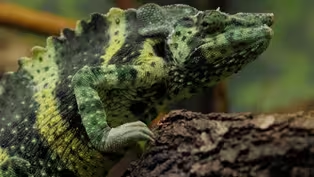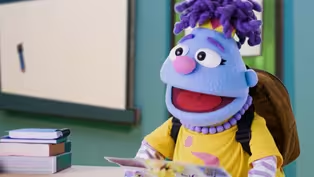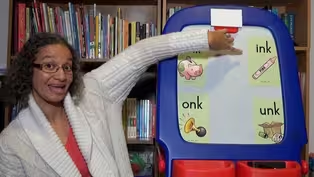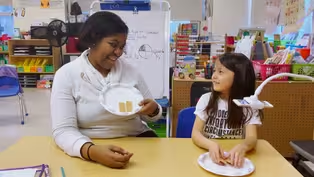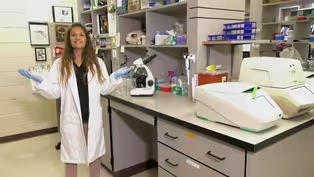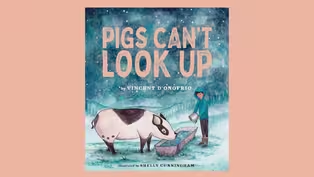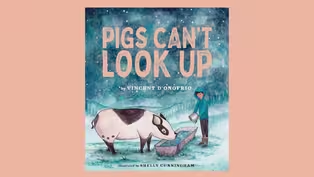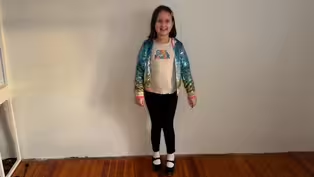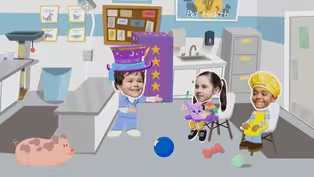
TEXTURE COLLAGE
Clip: 7/12/2024 | 7m 51sVideo has Audio Description, Closed Captions
Use your sense of touch to create collages with different kinds of textured paper.
With Daniel Mantilla from Studio in a School, use your sense of touch to create collages with different kinds of textured paper.
See all videos with Audio DescriptionADProblems playing video? | Closed Captioning Feedback
Problems playing video? | Closed Captioning Feedback
Let's Learn is a local public television program presented by THIRTEEN PBS

TEXTURE COLLAGE
Clip: 7/12/2024 | 7m 51sVideo has Audio Description, Closed Captions
With Daniel Mantilla from Studio in a School, use your sense of touch to create collages with different kinds of textured paper.
See all videos with Audio DescriptionADProblems playing video? | Closed Captioning Feedback
How to Watch Let's Learn
Let's Learn is available to stream on pbs.org and the free PBS App, available on iPhone, Apple TV, Android TV, Android smartphones, Amazon Fire TV, Amazon Fire Tablet, Roku, Samsung Smart TV, and Vizio.
Providing Support for PBS.org
Learn Moreabout PBS online sponsorship[bright music] - Hi, everybody, my name is Daniel.
Today we're going to explore textures using these special papers to make a collage.
I have different papers with different textures.
I have a background paper and I also have liquid glue in a cap.
We can also use our glue stick.
What do you think texture is?
Texture is the way something feels when you touch it with your hand.
Everything that we can touch and feel has texture.
Would you like to try?
We're gonna feel the table?
Everybody, how does it feel?
- Soft.
- Soft, maybe feels a little bit soft.
I feel that it's very smooth.
- Smooth.
- Smooth.
Now, everybody, feel your clothes.
How does it feel?
- Mine feels bumpy.
- Mine feels smooth.
- Smooth.
- Mine feels so bumpy.
- Mine feels a little bit soft.
Let's explore some of the textures that I have here.
We're gonna explore these textures using all of our senses.
So let's take a look at this one first, using our eyes.
What do you notice?
- It's bumpy.
- I noticed it's pretty wavy.
- So it's wavy, bumpy.
And I see a little bit of some lines here.
Now let's explore this texture using our fingers.
How do you think it feels?
- Bumpy.
- Bumpy, it feels bumpy, yes.
Now, do you think it makes a sound?
Let's try, I'm gonna use my nail, my finger, ready?
Listen carefully.
[paper clacking] - It does.
- It makes a sound, what kind of sound is that?
- A brighter sound.
- Yeah, and it's loud.
Now let's look at another texture.
First, let's use our eyes.
So I'm gonna remember that we are also feeling the paper.
I feel the paper and when I touch it it feels a little bit rough.
- Rough.
- Rough.
- Now, do you think it will make a sound?
Yes, let's try, listen carefully.
Ready?
[paper scratching] It does make a sound, like a scratchy sound.
Okay, let me show you this one.
Let's use our eyes.
What do you notice about this?
- It's blue.
- It's blue.
- Okay, I'm gonna touch it.
It feels very smooth, like the table, remember.
Now, do you think it will make a sound?
- Yeah.
- Let me try.
[paper scraping] - Very quiet.
- Yeah.
- Very soft, it's not as loud as the other two.
Are you ready for the next paper?
- Yeah.
- Okay, let's use our eyes.
What do you notice about this one?
- It's blue.
- How do you think this one feels?
- Soft.
- Soft.
- Soft, like our clothes, let me see.
Yes, when I touch it, when I feel it, it feels soft.
- That means it makes a sound.
- Do you think it's gonna make a loud sound or soft?
- Soft.
- Let's see, ready?
Listen carefully.
[paper scarping] It's very soft sound, right, okay.
Now we're going to use our textures to make a collage.
So I'm gonna choose my textures and I'm gonna use my background paper.
Now I'm gonna choose the bumpy one and I'm going to use the scratchy one.
Now, should I put them far apart or close together?
- Close.
- They can be close together.
- If they be on top of each other they'll be a little soft and scratchy.
- I'm gonna try that, when we put two on top of the other we overlap.
Maybe I'm gonna put this two far apart and I would like to have one blue piece on top of my sandpaper or the rough paper.
Okay, I'm going to use my glue to be able to put my pieces on the background.
I'm gonna turn this bumpy texture over because I would like for everybody to see the bump beside.
And I'm gonna put some glue on the back.
I'm gonna go dip, dip, dip, wipe, wipe, wipe.
Spread, spread, spread like butter on bread.
Would you like to do it with me?
So let's do it together.
- [All] Dip, dip, dip, wipe, wipe, wipe, Spread, spread, spread like butter and bread.
[whimsical music] Press, press, press.
- Excellent.
Now it's gonna be your turn to explore different papers with different textures and you're going to arrange them to be able to make a collage.
Are you ready?
- I'm ready.
- I'm ready.
- Ooh, I have a green bumpy one.
- Me too, I have a yellow one.
- I have a red, bumpy one.
- I love that you're touching the texture.
Are you making a sound with it?
[paper scraping] Is it loud or soft?
- Loud.
- [Daniel] A little bit loud.
- I wanna place it like right here, next to the edge.
- How did you put the one next to each other?
- No, I put it on top.
[paper scraping] - If you do it fast on here it goes really loud.
[paper scraping] - [Daniel] How did you make that sound?
- I scratched.
- You scratched.
Artists, are you ready to keep this arrangement?
- Yeah.
- Yeah.
- [Daniel] So what do we need to be able to keep our arrangement?
- Glue.
[whimsical music] - How does the last one feel?
Is it soft, is it bumpy?
- Soft.
Dip, dip, dip, wipe, wipe, wipe.
- What texture are you gluing now?
- This one.
- And how does it feel?
- Bumpy.
- The bumpy one, excellent.
[whimsical music continues] Okay, I love how you arrange your pieces and how you used the glue.
Now let me ask you, Mia, how did you arrange your pieces?
- I did this.
- Did you put them all separate?
- [Mia] I put my bumpy piece on the top.
- Cece, where do you have your bumpy pieces?
- On the top.
- What other textures did you use?
- The hard paper.
- [Daniel] And what color did you have?
- Brown.
And my rest of the paper is red.
- Now show me.
- So the bumpy piece is up here and this is the soft piece.
And this big soft piece is on the rough piece.
- Did you enjoy making a collage?
- Yeah.
- Excellent.
Now it is your turn to make a textured collage.
What kind of textures are you going to use?
How are you going to arrange them?
Have fun, artists.
ANIMAL ADAPTATIONS: CHAMELEON AND BLUE AND GOLD MACAW
Video has Audio Description, Closed Captions
Clip: 7/12/2024 | 5m 21s | See how a chameleon's feet are similar to those of a blue and gold macaw. (5m 21s)
FEEL YOUR BEST SELF: GROUND IT DOWN
Video has Audio Description, Closed Captions
Clip: 7/12/2024 | 4m 10s | When you are upset, learn to calm down by feeling like a tree rooted into the ground. (4m 10s)
GLUED/WELDED SOUNDS: ANK, INK, ONK, UNK
Video has Audio Description, Closed Captions
Clip: 7/12/2024 | 9m 21s | Explore glued and welded sounds "ank," "ink," "onk," and "unk" with Anna Scretching-Cole. (9m 21s)
Video has Audio Description, Closed Captions
Clip: 7/12/2024 | 7m 53s | Tahese Warley leads a fun math activity involving fractions, crackers, and the 5 senses. (7m 53s)
Video has Audio Description, Closed Captions
Clip: 7/12/2024 | 2m 31s | Meet a scientist -- an important helper who finds ways to improve our world. (2m 31s)
Video has Audio Description, Closed Captions
Clip: 7/12/2024 | 9m 31s | Anna Scretching-Cole reads PIGS CAN'T LOOK UP by Vincent D'Onofrio. (9m 31s)
Video has Audio Description, Closed Captions
Clip: 7/12/2024 | 9m 31s | Anna Scretching-Cole reads PIGS CAN'T LOOK UP by Vincent D'Onofrio. (9m 31s)
Video has Audio Description, Closed Captions
Clip: 7/12/2024 | 1m 34s | Violet teaches tap dancing moves! (1m 34s)
WORDSVILLE: THE CASE OF THE ASTONISHING ABSENCE
Video has Audio Description, Closed Captions
Clip: 7/12/2024 | 7m 27s | Help find Vet Wilder's missing magician hat that has the word "astonishing" written on it. (7m 27s)
Providing Support for PBS.org
Learn Moreabout PBS online sponsorshipSupport for PBS provided by:
Let's Learn is a local public television program presented by THIRTEEN PBS
